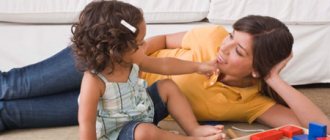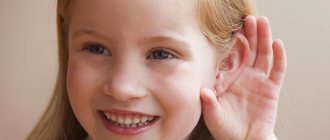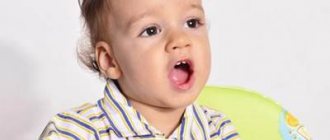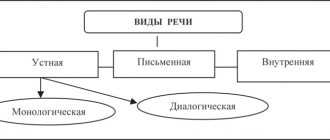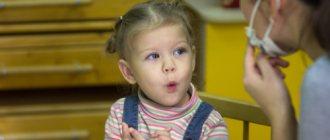Age norms for speech development at 2-3 years
Each age has its own vocabulary, certain pronunciation skills, and the degree of understanding of other people’s speech. So, the baby babbles his first words at the age of about a year. At first they are indistinct, but over time they become more and more clear. By the age of 2-3 years, the basic speech base is already formed, therefore, from birth to 3 years, you need to pay special attention to the development of the baby’s speech.
Speech norms for children 2-3 years old :
- The vocabulary of a 2-year-old child is approximately 200-300 words, and after six months the number of words reaches 1000-1200. More than half are nouns, with verbs in second place. By the age of three, the active use of adjectives, pronouns, adverbs, prepositions and conjunctions begins.
- The child is able to construct simple sentences of 2-3 words, explain what he needs, and communicate with peers. These are mostly declarative or exclamatory sentences. Single words are used as questions: where, how, why.
- The child names the size of the object (large - small), color, taste (sweet - salty - sour), shape (circle - square), quality (bad - good).
- Generalizing words appear in speech. For example, an orange, an apple, a pear are fruits, shoes, slippers, boots are shoes.
- Lightweight words like “bi-bi” and “tu-tu” disappear from speech.
- The baby understands the adult’s address to him.
- Incorrect use of declensions, numbers and genders is possible. By the age of three, their use should correspond to the language norm.
- Children at this age love to invent their own words. Substitutions of letters are possible, syllables in long words are swapped or shortened. For example, a spatula is a shovel, Vaseline is majeline, etc.
- Two-year-old children have difficulty pronouncing hissing sounds, replacing them with whistling sounds. Hard sounds are often replaced by soft ones, and this is normal. Some children already pronounce most sounds by the age of three, even the most complex ones - l, r.
Communication with parents and loved ones is the main source of information for a child. He unconsciously copies those with whom he is close.
Advice At the age of 2-3 years, the child’s attentiveness increases, he begins to listen to the speech of others. Children are very sensitive to the norms of language, so it is important to speak to them correctly: pronounce sounds clearly, do not lisp, use understandable words, take your time, speak with expression.
Game "Who eats what"
These are simple games. The first game is based on the child's knowledge of the nutrition of domestic and wild animals.
At the initial stage the following pairs are used
- The cow eats grass.
- The goat eats grass.
- The horse eats grass.
- The sheep eats grass.
- The cat eats meat and fish.
- The dog chews on a bone.
- The bear eats honey.
- The hare eats a carrot (for children of a good level it is better to say that the hare eats grass, twigs and tree bark)
- The fox eats the hare.
- The mouse eats cheese.
Puzzle games and counting sticks are used.
If the child is good at “distributing” food to animals, you can play the game in reverse.
A child or an adult builds houses; we place food near each house (can be cut out of paper, molded from plasticine, etc.). The child needs to guess who lives in this house. If the animals are wild, then “lay out” food in the forest - make a forest out of the same sticks.
How to develop speech: games, exercises and communication
The speech development of 2-3 year old children largely depends on how much time parents devote to it.
A few rules to learn before starting classes:
- You need to start communicating with your child as early as possible, even when he is not yet born.
- During games and exercises, you need to look at the baby. Eye contact is a prerequisite for the emotional stability of the baby.
- The child should see how the muscles of mom or dad's face move when they talk to him. This way he will quickly match certain movements with sounds. During classes, it is useful to be in front of a mirror so that you can see all the movements of your face.
- The more repetitions, the better. At a younger age, you will have to repeat it ten or even twenty times so that the baby remembers better. This is normal, so parents need to be patient.
- The clearer, slower and louder the words are spoken, the faster and more accurately the baby will be able to repeat them.
- Any attempt to speak should be encouraged, even the most inept and unintelligible.
- And, of course, you can’t swear if something doesn’t work out. Over time, it will definitely work out, but the child may experience additional difficulties due to excessive emotionality of the parents.
- Classes should be carried out daily, but there is no need to overtire the baby. 10-20 minutes a day, divided into several short lessons, is enough.
- The more you read to your baby, the faster his vocabulary expands. Expressive reading will help you understand complex structures.
- The child's temperament must be taken into account. With high intellectual development, the baby may simply be silent.
Exercises for speech development:
- To expand your vocabulary, it is convenient to study words on general topics: fruits, clothes, animals, toys, etc. The parent clearly names the object and offers to repeat its name. It is useful to include definitions, for example, the ball is green, the cube is yellow. It would be good if additional words would emphasize the belonging of objects to gender or number. This way the child will quickly begin to catch the difference. Example: big doll - big ball, yellow pear - yellow cube.
- First, the parent names the object, and then this role is transferred to the child. You just need to point to an object and ask what it is. Any answer should be encouraged; if the child makes a mistake, then gently correct him.
- Give your child riddles. It's good if the answer rhymes. Examples of riddles: “Igo-go! - the child screams, that means it’s ... (foal).” Or: “Chick-chirp! Don't be timid! I’m an experienced... (sparrow).” Other riddles: “The monkey loves oranges and bananas very much.” “He purrs and sings. Did you guess it? It's a cat)".
- Read simple poems to your child and ask him to complete the phrase. After several readings, he will remember the last words.
- For the little ones: the mother pronounces the first part of the word, and the son or daughter finishes it. This is how words of 2-3 syllables are learned: shop, dog, car, road, etc.
- Let the child determine the diminutive form of the object. For example, an adult asks the question: “What is the name of the cat’s child?” The kid answers: “Kitten.” And so on: puppy, chicken, duckling, baby elephant.
- To develop imagination, it is useful to ask questions such as: why do we need water? spoon? cup? Let the baby dream up.
The most effective are those classes that are conducted in a playful way . The child feels relaxed and is interested in doing fun and active tasks. Games for developing speech for children aged 2-3 years:
- Imitation of sounds of animals, birds, objects. You need to invite the child to depict the simplest sounds: bees, cows, cats, dogs, rooster, steam locomotive, etc.
- Let the baby guess the sound. Play with him like this: portray some animal, and let him guess who or what such a voice belongs to.
- If there are toys in the form of animals in the house, make performances with them.
- A good exercise for the voice: arrange a competition to see who can hold on to the sounds “aaa”, “oooo” and others longer.
- Attention game: place objects on the table and let your child remember them. Then ask him to close his eyes and remove one object. Let him guess what is missing. Start with 2-3 items, gradually increasing their number. You can play the other way around: add a new item and ask the baby to find out what appeared on the table.
- Another game for attentiveness: ask your child to remember what you are wearing, leave the room, add one item (hat, scarf, glasses) and come back. The baby must understand what has changed.
Advice It will be interesting and useful for a child to exchange with parents. Let him take on the main role: ask a riddle, ask a question, hide an object, or change clothes.
Don't ignore the exercise of your tongue and lips . General gymnastics for the development of facial muscles will be useful:
- Pull out your lips with a tube.
- Stretch your mouth into a smile.
- Smile, showing your teeth.
- Let the child just make funny faces in front of the mirror.
Tip If your child cannot give the answer to a riddle, let him think for a while, and then clearly state the correct answer. In time he will remember it.
Reasons for rejection
A child becomes non-verbal as a result of not only psychological disorders. The social environment plays an important role in the development of speech. If parents do not talk to the baby from birth, do not spend time together playing games, and the baby is left alone with himself in the sandbox during a walk, RDD may occur. It is more difficult to learn speaking if there is no communication with other children, people other than mom, dad, and grandmothers. It is easier to teach speech when the child enjoys playing together. If parents have chosen the wrong, uninteresting development program, the baby may be lazy to study and not be active.
Psychologists say that speech delay often occurs as a result of the child’s character traits, which is not a negative factor. Parents should not force a child who is shy and timid to speak. A one-year-old boy or girl can be sociable and active, play with other people and children, and upon reaching the age of two, become modest and unsociable. This is due to age characteristics, the crisis of 3 years of age, when the baby begins to divide adults into “us” and “strangers”. Heredity plays an important role. If mom or dad started speaking late, the child repeats the speech behavior of the parents in 70% of cases.
The provoking factor for the development of mental retardation is the lack of need for speaking. Moms and dads love to fulfill the child’s requests the first time, sometimes the baby doesn’t even say the wish, he points with his finger, “moos.” Parents guess what the baby needs without words and fulfill the request, which is wrong. The child lacks motivation to speak when he is already understood. If the baby points with his finger and does not want to speak, psychologists advise saying: “I don’t understand what you want, tell me,” more often to provoke situations that complicate the child’s activities without language.
Among the pathological causes of FGR are:
- Neurological disorders.
- Somatic pathologies.
The benefits of finger games, drawing, modeling and other types of children's creativity
Pediatricians always recommend that parents massage their baby's hands, and when he grows up, play finger games with him. The fact is that hand exercises will stimulate those areas of the brain that are responsible for speech. The more flexible a baby’s hands are, the faster he begins to pronounce intelligible words, the faster he learns new ones, constructs sentences, and reacts to the speech of adults.
Games can begin with regular massage, rubbing, and tapping. At 2-3 years old you can play nursery rhymes with your child. The parent recites a poem, and at this time the child performs some actions with his hands. The most popular nursery rhyme games: “Ladushki”, “We shared an orange”.
Fine motor skills are significantly affected by activities such as drawing, modeling with plasticine, cutting out paper, etc. Give your child simple tasks: draw a ball, a sun, a cloud, a flower. Tell a fairy tale and draw its main character together. Contact with small objects also helps develop speech. Let the child pick up buttons, beads, pencils, and learn to tie his own shoelaces.
It is recommended to perform breathing exercises. It saturates the child’s body with oxygen and energizes it. Children who breathe correctly move more actively, think better, and therefore develop faster, including in speech. Breathing exercises are also performed in the form of a game. All children like to blow soap bubbles and balls. Place candles on the birthday cake: let the child try to blow them out, making a wish.
Recommendations from a psychologist and speech therapist to parents
It is necessary to start learning from an early age; two years is a suitable period for the development of psychological processes and speaking through active joint activities. You can conduct classes with your child several times a day, at home, during a walk. To start the process of speech acquisition, you should follow a number of simple rules:
- Help the baby master the world around him. On the street (especially in the summer), talk more with your child about natural phenomena, what color the surrounding objects are, what are the names of animals running past, visit musical theaters, the circus.
- Develop fine and gross motor skills, engage in modeling. Today you can buy a variety of plasticine in stores: soft, kinetic, plastic, colored dough. Classes contribute to the development of mental processes and perseverance, which is reflected in the speed of speech acquisition.
- Teach your child the names of animals as they speak.
- Kids love to listen to adults read fairy tales and poems. It is a mistaken opinion that a child does not develop when he or she does not read a work independently. When listening, thinking, memory, perception, attention, and comprehension develop. It is important to ask your child questions while reading a fairy tale and discuss the characters. If the baby does not speak, the parents themselves show him an example: “Wow, what a cunning fox, huh?”
What toys, books and aids can be used for speech development
To help parents, there are special benefits that will accelerate the baby’s speech development. Most often these are cards with pictures. It is very useful to accompany classes with images of objects. Looking at the card, the child will first name what is shown on it. Then you can come up with a short story together about this animal or object.
Children are developed by blocks, puzzles, toys, construction sets, including Lego. You need to start with 3-4 parts, increasing their number with age. Toys are always included in educational games. The most convenient object is a ball. The favorite children's game - "Edible - inedible" is impossible without this item. Let your child catch the ball when you say something is edible, and return it when you say the opposite.
Other ball games:
- Mom throws the ball and names the letter. The child catches it, comes up with a word starting with the named letter, pronounces it and throws the ball to his mother.
- With older children, try playing antonyms. Mom throws the ball and says a word, and the child comes up with the opposite: day - night, light - shadow, fast - slow, black - white, etc.
Listening to sounds should be included in your classes. It’s good if you have the opportunity to take your child to the zoo.
Useful books for speech development:
- E. Yanushko “Speech development in children 1-3 years old.”
- S. Batyaeva, E. Savostyanova “Album on speech development for the little ones.”
- L. Smirnova “Speech development in children 2-3 years old.”
- A. Astakhov “My first book.”
- O. Zhukova “Baby’s first textbook.”
- All books with folk tales and pictures, alphabet.
It is important to remember: a child’s speech develops especially intensively at the age of 2-3 years.
The speech activity of a child at 2-3 years old undergoes the greatest changes. It is at this time that its formation takes place, a base is developed on the basis of which development will subsequently take place.
Speech development of young children
Development is comprehensive and affects many areas. This includes expanding the vocabulary, working on sound pronunciation, and the process of building coherent speech (monologue and dialogue). All stages must occur under parental supervision and with the direct participation of adults.
Exercises to develop phonemic awareness
It is necessary to conduct classes on the development of phonemic hearing in an environment familiar to the child and always in a playful way. The child must understand what is required of him, so it is important to have a competent introduction to the game - ask the right questions (short and as simple as possible).
- Show me where the sound comes from? The child closes his eyes and then gestures with his hand to show where the sound came from.
- Clap like me. Repeats the number of claps after an adult.
- Clap when you hear the water's song (ssss). The child must choose the one he needs from a set of sounds.
Speech development in young children
The greatest impetus for the emergence of speech occurs during the socialization of the child. In kindergarten, there are often children who already speak, and who, one way or another, are followed by the rest.
Note. The process of speech development in a group goes much faster than individually.
Grammatical features of speech
At two or three years old, the child’s grammatical structure of speech is practically not formed. New word forms are possible, and even encouraged - this feature means that the child analyzes speech and, based on his little life experience, tries to choose the appropriate form. Errors in declensions and the use of prepositions also correspond to the age norm.
How fine motor skills affect speech development
One of the technologies for speech development is the use of numerous exercises for fine motor skills of the hands. To construct a sentence, you need to master motor planning - clearly know what to say and in what sequence. Tasks that require the participation of fine motor skills of the hands are aimed primarily at the development of motor planning. Thus, introducing these exercises to the general complex of speech development will contribute to the rapid emergence of speech in the baby.
Development of fine motor skills
Difficulties with speech development: how to determine
All children are different: some build sentences by the age of three, while others use a small number of words. Any developmental norms are conditional; speech skills directly depend on the child’s temperament and his needs. Some children just need to name the object to get it, so they don't use complex constructions.
Sometimes you can independently determine that a child has a delay in speech development based on a number of signs. Some of them are obvious:
- Severely limited number of words used.
- It is difficult for a child to answer simple questions.
- It is difficult for him to repeat a sentence of 4-5 words after an adult.
- When pronouncing certain sounds, part of the face noticeably tenses.
- Frequent replacement of syllables and sounds in words.
- The baby does not understand the meaning of poems and fairy tales.
- He has difficulty with age-appropriate intellectual games. For example, it is not possible to assemble cubes or pictures with more than 4 parts.
- The child speaks too quickly.
- The child refuses to speak.
The reasons for developmental delays can be both physical characteristics and lack of attention from parents. In the second case, this is easy to fix. There are a lot of educational games, exercises, poems. In any case, the child needs to be shown to a speech therapist and neurologist to find out if there are structural defects in the speech apparatus or brain problems.
Games to develop phonemic awareness
Phonemic awareness is a person's ability to hear, distinguish and recognize sounds. This ability also helps develop speech.
The following simple games are possible:
- An adult includes the simplest and most common sounds: birdsong, the sound of rain or thunder, the noise of a train. The child’s task is to guess what he heard.
- The child closes his eyes, and the adult walks around the room with a bell in his hands. The baby needs to find an adult by ear. You should not walk with your eyes closed for the safety of your baby. It is enough to name where the adult is.
- An adult shows a picture depicting everyday situations. The child names sounds that fit the situations in the picture. For example, in the image, a girl puts a doll to sleep, and the child must sing a lullaby.
- Logorhythmics is a combination of movement, speech and sounds. Logorhythmics is easy to practice at home: turn on a children's song, dance to it and reproduce lines from the songs. It is advisable not just to dance, but to depict the situation that is being sung about.
What to do if the child does not speak
When such a problem arises, many parents begin to sound the alarm. Before drawing conclusions, you need to show the child to a specialist - a speech therapist, and sometimes a neurologist. Possible problems that prevent you from speaking may include malocclusion, neurological pathologies, and hearing problems. The speech therapist must identify speech delay at an early stage; the sooner the correction begins, the more successful and easier it will be. You can show your child to a specialist as early as 2-3 years old. Speech development classes will not necessarily include diction training. They can be aimed at solving problems with hearing, attentiveness, and expanding vocabulary.
The development of speech skills up to 3 years is an important stage in the formation of a child’s personality. The sooner the baby can express his needs, the easier it will be for him to find a common language with his peers. Children with whom their parents were actively involved are more emotional, begin to show interest in surrounding objects early, and develop creatively. Even if the baby has no signs of developmental delays, home activities and games will be no less important.
Game "Big - Small"
This game, like all the previous ones, is quite simple, but there are several variants of the game, which I will now tell you about.
- We compare big with big, and small with small. For example, a large car and a large locomotive, a small car and a small locomotive.
- We put the big to the big and the small to the small.
- For example, a large plate contains large spoons, and a small plate contains small spoons.
- We are looking for small objects among large ones, and large objects among small ones.
- We select pairs: small - large.
- We make big from small and vice versa. For example, you made a small house out of sticks, and then you can make a big one, and then make a small house out of the big house, and a big one out of the small one.
Possible speech defects
There are situations when children, without any problems, are simply too lazy to say words out loud, confident that they will understand them anyway
Parents should pay special attention to the child if he speaks little, confuses syllables and words, does not understand the meaning of what was said - most often this is due to various speech defects that will have to be corrected in speech therapy classes
There are several types of speech impairment possible:
- stuttering;
- dyslalia - children with normal hearing and speech apparatus confuse the consonant phonemes and , and .
- nasality - pronouncing words “in the nose”, which makes understanding the child very problematic;
- the child does not understand the parents’ speech and does not speak himself;
- pronounces sounds incorrectly – difficulties with articulation.
In case of any of them, you should start speech therapy classes - with a professional defectologist and at home, otherwise the child will be left with delayed speech development and may not be accepted into a comprehensive school, or may be asked to attend a specialized institution. But the situation can be corrected through speech therapy.
Game “What color is this?”
This game involves working with the activation of a dictionary of color names (at the initial stage we take four primary colors (blue, red, green, yellow) and then add white, black colors of the rainbow and tint colors.
But if the child does not know the colors or has not remembered them, then this game will have the goal of teaching the child to distinguish and name colors.
So here are some game options, from easy to hard
- The adult names the colors of the objects (since we take 4 colors, then there are also four objects. If the child has attention deficit, you can take two. And then asks the child the task: “Show the red (blue, yellow, green) object.
- Select items by color. Group.
- Name the colors of objects.
- Select an object that is extra in color.
We teach how to correctly imitate the speech of adults
When organizing speech therapy classes for children 2-3 years old, follow the main rule of communication with your child: never distort words.
READ ALSO: development of a 2-year-old child A child is a great imitator, he imitates cartoon characters and mom and dad. If you talk to him, distorting words, he will perceive such sounds as correct and begin to repeat them. Try to pronounce words clearly, only occasionally using diminutive or inverted forms.
The next stage is sound pronunciation. If you want to teach your child simple sounds, make activities with him or her playful. Use the following exercises:
- Dudochka. Musical instruments always arouse curiosity and interest in children; they help non-verbal children learn sounds more easily. You can buy a toy in a store or imitate playing the instrument with your fingers. Show your baby what a pipe sounds like by saying “doo-doo-doo,” then ask him to repeat the sounds.
- Driving by car. Favorite game of all children. Place your son or daughter on your lap, start the engine, and let's go. Turn the steering wheel and honk, saying “beep.” Kids really like this ride, they play with it with pleasure and quickly learn to “beep.”
- Home zoo. Gather soft toys or animal magnets in one place and take a tour of your home zoo, asking your child to join you in saying the sounds each animal makes. They will help you master sounds and cartoons about animals.
Useful tips
Parents should be aware of the following points:
- Practice only when the child is in the mood to play. You should not force your son or daughter to take speech therapy classes.
- Show more patience, encourage your child, don’t scold him, don’t demand immediate correct pronunciation.
- Compose and invent new games according to the scheme of the previous ones, let your favorite children's characters and heroes of games and cartoons appear in your games.
- Do not despair if at first the child complains of fatigue. Gradually, his speech apparatus will become stronger, and correct reproduction will become the norm, a natural process.
Watch another game for speech development in the following video.
